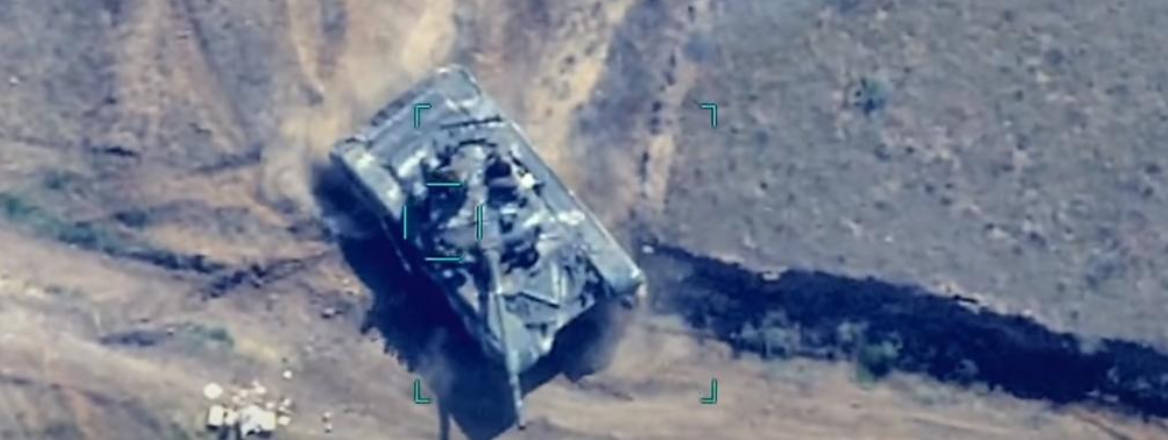The Key to Armenia’s Tank Losses: The Sensors, Not the Shooters
Amid a lively debate about the viability of the UK’s heavy armour, the loss of over 42 Armenian T-72s to Azerbaijani forces in Nagorno-Karabakh requires further analysis.
Despite the heavy Armenian armoured losses, the key lessons from the videos Azerbaijan has published online are not about armour. Rather, they reflect how the density of sensors on the modern battlefield is changing the balance in combined arms warfare.
Before tackling this, some myths need to be challenged. There is a tendency for Western soldiers to dismiss what can be learned from these incidents because the videos show limited tactical proficiency being displayed by Armenian troops. This is misguided for several reasons. The snippet videos usually show armour manoeuvring, when camouflage is hard to maintain, and which Western forces would equally have to do if they were to affect the outcome of battle. The videos have also been selected as examples of Azerbaijani successes. However, there is actually a lot of evidence of Armenian forces digging in, concealing positions, and deploying decoys, of which at least two were struck by Azerbaijani forces.
More importantly, this dismissal of evidence suggests a lack of appreciation of just how naked the modern battlefield has become. Against a peer adversary it is entirely reasonable to expect the battlefield to be swept by ground-moving target indicator (GMTI) radars, with tactical units able to scan terrain out to 150 km. Night or day, unusual cross-terrain movements, coordinated spacing, and lack of adherence to civilian roads, all make military vehicles highly distinct to trained operators.
A further layer of scrutiny will come from electronic warfare units. Dependency upon radio in Western operations is a hard habit to kick, especially given the stringent safety standards in exercises. Western forces tend to leave a tell-tale map of electronic signatures for an adversary to analyse. Even platoon infantry attacks tend to see a lot of exchanges on the company net. For a competent adversary these signatures offer another potent tool to map Western forces’ movements.
Such stand-off ISTAR techniques are unlikely to provide track-quality targeting solutions, unless the adversary intends to saturate a large area. It is the threat of area targeting that has driven the UK to experiment with dispersed manoeuvre with its STRIKE concept, rendering long-range area saturation uneconomical. But these techniques will be quite capable of identifying areas of interest to prioritise the allocation of UAVs and other electrooptical sensor bearers.
The hope that camouflage will conceal vehicles from observation is highly optimistic. The proliferation of infrared and thermal imaging cameras makes concealment harder – by night or day – and even vehicles under thermal screens can often be given away by personnel leaving those screens to urinate or similar, all too human, needs. More importantly, some traces are hard to cover. The best evidence that armour will be unable to hide is that Western tracked vehicles struggle to avoid observation by friendly UAVs on exercise, which can quickly follow track marks on the ground to the woodblock where a vehicle is hiding.
To conclude from this that the tank’s days are numbered, however, is a serious error. From the videos in Nagorno-Karabakh it is evident that unarmoured vehicles and dismounted infantry are faring no better, even those dug into positions with camouflage screens. Indeed, the lack of protection means they will likely fare worse since there are more kinds of munitions that are lighter and easier to employ that can kill them.
Besides the vulnerability of other kinds of vehicle, the ability to inflict persistent attrition upon an adversary at reach does not change the fact that land warfare is about taking and holding ground, and the ground will still ultimately need to be assaulted. Once committed to an assault on defended positions, armour remains critical to rapid success with acceptable losses. The challenge is to get a combined arms formation within striking distance without it having suffered heavy losses before entering the direct fire zone. Armenia, for instance, has lost the equivalent number of tanks to more than a third of the UK’s heavy armour inventory.
The lessons are far reaching. Heavy formations must likely disperse to avoid being engaged by area-of-effect munitions at reach. This makes protecting them from UAVs and air attack more challenging, requiring the integration of short-ranged air defences (SHORAD) across tactical units, along with EW – specifically electronic attack – capabilities. This means a move away from camouflage towards hard protection, able to sanitise areas of the battlefield of enemy ISTAR assets. This does not prevent detection, however, since finding UAVs and engaging them will require radar – especially at night – which implies the need for emissions detectable by enemy EW.
Therefore, a broader shift in mindset is required as to how combined arms manoeuvre functions. Infliction of attrition against enemy ISTAR must be prioritised to degrade the enemy’s sensor picture to a point where they will struggle to distinguish decoys from real targets. Deception, saturating the electromagnetic spectrum, and other active rather than passive means will be needed to protect the force as it moves into direct contact. Once in contact many traditional tactics and capabilities will remain relevant.
A critical challenge to be worked out is how to transition from a dispersed approach to a concentrated attack, since at the forming-up point there will be a significant vulnerability to artillery, anti-tank guided weapons and other threats. This is a key area of focus in developing robust tactics.
Challenges like this transition – ultimately resolvable through tactics and the employment of systems of technologies – highlight how the debate over future capabilities needs to shift. The challenge is not whether tanks are obsolete, but how a system of capabilities can be fielded and trained that gets the force to where it needs to be, with enough combat power to achieve the desired result. It is the system, not the platforms, and the balance within that system that we need to get right.
That new system of fighting – understanding the balance of capabilities critical to the future of combined arms operations – must also go further than articulating how to blind the enemy’s sensors. It must also outline how to reverse the calculus and impose comparable challenges on the enemy. Here there are more difficult structural questions to be resolved. The British Army had intended to disband 32 Regiment Royal Artillery, responsible for employing tactical UAVs, because it felt that UAVs should become organic across the force. There is a risk, however, that this would leave UAVs as an enabler to augment what regiments do already. The absence of a community of excellence to challenge thinking, develop new tactics and inform other units about the implications, is a problem, which has led to the regiment ultimately being retained. At the same time, keeping UAVs as a capability integrated throughout the force promises to encourage combined arms employment. Similar challenges might be asked about counter-UAV and EW systems. Should they be grouped at echelon, or attached organically to manoeuvre elements? If the latter is pursued, how can British forces avoid fratricide in the electromagnetic spectrum?
The answers to these questions can only be found through experimentation. In that sense while the conflict in Nagorno-Karabakh highlights some key deficiencies in British forces – SHORAD, EW, UAVs – the answer cannot be a series of binary trade-offs between platforms. Instead, it cuts to the heart of what the Chief of the General Staff, General Sir Mark Carleton-Smith, highlighted in his recent address on the Integrated Review: the British Army should build a force fit for a new age of warfare.
Jack Watling is Research Fellow for Land Warfare in the Military Sciences team at RUSI.
Dr Jack Watling
Senior Research Fellow, Land Warfare
Military Sciences


